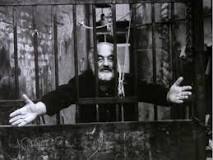 Earlier this summer, a minor kerfuffle over an exhibition of artworks by famed Armenian filmmaker Sergei Parajanov (1924-1990) underscored a more serious problem facing Armenian culture and Armenia in general -- and, by extension, many of the former Soviet republics. Parajanov, born Sarkis Hovsepi Parajaniants, was one of the great Soviet-era filmmakers and an important force in 20th-century cinema. Simply put, the dispute lay in the fact that the exhibition at GiIbert Albert in New York City (June 16-30) was sponsored by the Russian American Cultural Foundation (RAF) as part of its Russian Heritage Month, although Parajanov was born in Tbilisi, Georgia, to an Armenian family. He is buried at the Pantheon in Komitas Park, Yerevan's equivalent of Père Lachaise.
Earlier this summer, a minor kerfuffle over an exhibition of artworks by famed Armenian filmmaker Sergei Parajanov (1924-1990) underscored a more serious problem facing Armenian culture and Armenia in general -- and, by extension, many of the former Soviet republics. Parajanov, born Sarkis Hovsepi Parajaniants, was one of the great Soviet-era filmmakers and an important force in 20th-century cinema. Simply put, the dispute lay in the fact that the exhibition at GiIbert Albert in New York City (June 16-30) was sponsored by the Russian American Cultural Foundation (RAF) as part of its Russian Heritage Month, although Parajanov was born in Tbilisi, Georgia, to an Armenian family. He is buried at the Pantheon in Komitas Park, Yerevan's equivalent of Père Lachaise.
 Members of the Armenian diaspora were particularly incensed by what they perceived as an act of overt cultural imperialism on the part of "the Russians," made seemingly worse by the fact that the works were presented under the auspices of the Republic of Armenia's first lady, Rita Sargsyan. In their view, the contemporary Republic of Armenia was being complicit in undermining its own people's history and culture. Art historian Tamar Gasparian-Hovsepian wrote an impassioned and well-reasoned letter titled "Parajanov Rolling in his Grave":
Members of the Armenian diaspora were particularly incensed by what they perceived as an act of overt cultural imperialism on the part of "the Russians," made seemingly worse by the fact that the works were presented under the auspices of the Republic of Armenia's first lady, Rita Sargsyan. In their view, the contemporary Republic of Armenia was being complicit in undermining its own people's history and culture. Art historian Tamar Gasparian-Hovsepian wrote an impassioned and well-reasoned letter titled "Parajanov Rolling in his Grave":
The irony, of course, is that Parajanov ... was neither an ethnic Russian nor did he ever consider himself Russian. Actually, it was the Russian-Soviet state that condemned him as a public enemy and a criminal, primarily due to his sexual orientation and also his art. He was imprisoned and sent to work in hard labor camps. ...
Today, we know what Russia did to Parajanov's three Motherlands. Without having to go too deep into history, one can consider the Russian-Georgian relationship and the war, as well as the recent developments in Ukraine and the annexation of Crimea by Russia. And then there is Armenia, also under pressure to join the Putin-led Eurasian Customs Union. With Putin's stated longing for the return of the good old days of the USSR, bringing small, landlocked republics like Armenia back into the fold is one more step in that direction.
True, Parajanov lived and created during the Soviet period. Yet that doesn't automatically make his art and legacy a part of the Russian culture....
Worse yet, lovers of Parajanov might have taken issue with the fact that the show took place in a Midtown jewelry store, of all locations, rather than in a proper art gallery. (Are you listening, Larry Gagosian?) Not surprisingly, the works, encased in glass, were difficult to view and lost much in their presentation.
To many people looking in on this particular cultural skirmish, it all seemed like a tempest in a Russian teapot of sorts. James Steffen, a film historian at Emory who wrote the catalogue essay for the exhibition, does in fact mention that Parajanov was Armenian. And Parajanov Museum curator Zaven Sarkissian noted in a separate interview that he had tried to mount a show of Parajanov's work for several years outside Armenia, without any Armenian organizations or philanthropists lending a hand, financial or otherwise. Fair enough. For better or worse -- mainly worse -- Armenians are notoriously practical and mercantile in their undertakings and neglect cultural funding to a deplorable degree. But for diasporan Armenians, the issue is serious. Armenians depend, to an alarming and increasing degree, on Russia for everything from military assistance to basic goods and, to a certain extent, for leverage against traditional enemies Azerbaijian and Turkey -- this in spite of the fact that Russia sells copious amounts of arms to both Azerbaijian and Armenia. There are also 1 million Armenians in self-imposed exile in Russia, where work is easier to find than in the beleaguered Armenian Republic. Ties between Armenia and Russia run deep: Armenia is, for all intents and purposes, a vassal state of its northern neighbor; in fact, Russia's current foreign minister Sergey Lavrov is of Armenian descent.
Christian Armenia is surrounded by unfriendly and mostly Muslim states (with the exception of Georgia and Iran, with whom it has tenuous and strong relations, respectively). Armenia does not, to the best of anyone's knowledge, possess a hydrogen or nuclear bomb. However, it is technologically advanced and does possess a large nuclear reactor in Metsamor and an army that punches way above its weight. So Armenia remains vulnerable. After the Armenian Genocide of 1915, in which 1.5 million Armenians were slaughtered by Ottoman Turkey along with 1.5 million Assyrians, Pontic Greeks and Alevis, Armenia was incorporated into the Soviet Union against its will, initiating a 70-year period during which the motto "Better red than dead" generally prevailed in the Armenian diaspora.
The Armenian government finds itself between the proverbial rock and a hard place, a political Scylla and Charybdis. The official policy that it has followed since independence, which it termed "complementarity," is a delicate balancing act meant to take advantage of Western and Russian support, or at least not overtly take sides. The idea is to avoid the fate of neighboring Georgia, whose one-sided, pro-Western orientation eventually led to that republic losing key territory to Abkhazians and South Ossetians after Russia bombed it into submission in 2008 during what is now referred to in the West as the Russian-Georgian War. And Vladimir Putin has recently flexed his muscles and is more or less forcing Armenia to join the Eurasian Customs Union (which it sponsors) rather than that of the European Union -- against almost everyone's better advice. Armenia has seen what happened in Georgia and the Ukraine, former republics that have chafed at Russian concerns and angered the Great Bear Up North. As with all small countries, the obvious answer for Armenia is to become truly self-sufficient. But in contravention to the 1920 Treaty of Sèvres and Woodrow Wilson's "Mandate for Armenia," the country was carved out by Lenin and Ataturk in 1921 after the Armenian Genocide, with only 10 percent of its historic homeland, and in such a way that it is now a long, almost indefensible sliver of land lacking a coastline. Natural resources are scarce, so, like Israelis or Singaporeans, Armenians must rely on their brain power -- and they have plenty of it -- and a powerful diaspora as its primary resources. As one might expect, these aren't exactly the strongest bargaining chips when compared with Baku's huge oil reserves. Like Jews, though, Armenians seem hellbent on survival and won their most recent conflict with the Azeris over the Armenian-populated enclave of Nagorno Karabagh.
In the end, the New York Parajanov exhibit seems to have gone off without much of a hitch. A solution might have been to have presented him in a more fitting context -- say, as part of an Armenian Cultural Week or by presenting Parajanov as an Armenian artist who studied and resided in Russia for part of his life. The fact that much of this time was spent in a prison in Siberia, where he was imprisoned for being gay and a troublemaker of the most laudable sort, is an irony, I am sure, that would have been lost on no one.